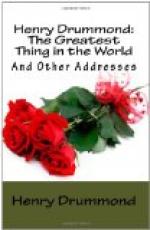“I lived for myself,
I thought for myself,
For myself, and none beside—
Just as if Jesus had never
lived,
As if He had never died.”
Thank God the Christianity of today is coming nearer the world’s need. Live to help that on. Thank God men know better, by a hair’s breadth, what religion is, what God is, who Christ is, where Christ is. Who is Christ? He who fed the hungry, clothed the naked, visited the sick. And where is Christ? Where?—“Whoso shall receive a little child in My name receiveth Me.” And who are Christ’s? “Every one that loveth is born of God.”
LESSONS FROM THE ANGELUS.
God often speaks to men’s souls through music; He also speaks to us through art. Millet’s famous painting entitled “The Angelus” is an illuminated text, upon which I am going to say a few words to you to-night.
There are three things in this picture—a potato field, a country lad and a country girl standing in the middle of it, and on the far horizon the spire of a village church. That is all there is to it—no great scenery and no picturesque people. In Roman Catholic countries at the evening hour the church bell rings out to remind the people to pray. Some go into the church, while those that are in the fields bow their heads for a few moments in silent prayer.
That picture contains the three great elements which go to make up a perfectly rounded Christian life. It is not enough to have the “root of the matter” in us, but that we must be whole and entire, lacking nothing. The Angelus may bring to us suggestions as to what constitutes a complete life.
I.
The first element in a symmetrical life is work.
Three-fourths of our time is probably spent in work. Of course the meaning of it is that our work should be just as religious as our worship, and unless we can work for the glory of God three-fourths of life remains unsanctified.
The proof that work is religious is that most of Christ’s life was spent in work. During a large part of the first thirty years of His life He worked with the hammer and the plane, making ploughs and yokes and household furniture. Christ’s public ministry occupied only about two and a half years of His earthly life; the great bulk of His time was simply spent in doing common everyday tasks, and ever since then work has had a new meaning.
When Christ came into the world He was revealed to three deputations who went to meet and worship Him. First came the shepherds, or working class; second, the wise men, or student class; and third, the two old people in the temple, Simeon and Anna; that is to say, Christ is revealed to men at their work, He is revealed to men at their books, and He is revealed to men at their worship. It was the old people who found Christ at their worship, and as we grow older we will spend more time exclusively in worship than we are able to do now. In the mean time we must combine our worship with our work, and we may expect to find Christ at our books and in our common task.




